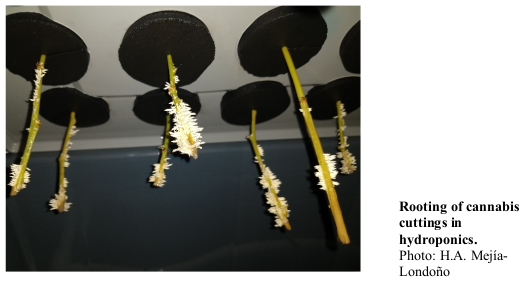Asexual propagation in female plants of cannabis (Cannabis sativa L.)

Abstract
Cannabis is a plant with an ancient tradition, currently of worldwide interest due to the effectiveness of cannabidiol (CBD) in different treatments. Asexual propagation techniques are used to preserve the characteristics of the mother plants. This work aimed to evaluate the efficacy of two planting methods (hydroponics and peat) for asexual propagation in female plants of cannabis using the cutting method. Cuttings taken from female plants were arranged in two planting methods, two additional factors were evaluated, management of the apex, and hormonal regulator in each medium. The cuttings were kept under controlled environmental conditions for 17 days. Cuttings propagated in peat in combination with the growth regulator registered the highest percentage of survival (100%) with respect to the hydroponic medium without regulator (73.33%). The cuttings that were not subjected to the apex cutting show the best results in the variables evaluated in both planting media. Both peat and hydroponics are effective means for cutting. Applying a growth regulator and keeping the whole leaves tips favor the formation and quality of the roots.
Keywords
Cannabidiol, Cutting, Naphthaleneacetic acid, Hydroculture
References
- Caplan, D., J. Stemeroff, M. Dixon, and Y. Zheng. 2018. Vegetative propagation of cannabis by stem cuttings: effects of leaf number, cutting position, rooting hormone, and leaf tip removal. Can. J. Plant Sci. 98(5), 1126-1132. Doi: https://doi.org/10.1139/cjps-2018-0038
- Cervantes, J. 2007. Marihuana: horticultura del cannabis. La biblia del cultivador médico de interior y exterior. 5th ed. Van Patten Publishing, Vancouver, WA.
- Chandra, S., H. Lata, and M.A. ElSohly. 2020. Propagation of cannabis for clinical research: an approach towards a modern herbal medicinal products development. Front. Plant Sci. 11, 958. Doi: https://doi.org/10.3389/fpls.2020.00958
- Chandra, S., H. Lata, I.A. Khan, and M.A. ElSohly. 2017. Cannabis sativa L.: botany and horticulture. pp. 79-100. In: Chandra, S., H. Lata, and M.A. ElSohly (eds.). Cannabis sativa L.: botany and biotechnology. Springer International Publishing, Cham, Switzerland. Doi: https://doi.org/10.1007/978-3-319-54564-6
- Chica, F., M. Gómez, E. Castro, S. Cardona, and Grupo Biotecnología. 2016. Parámetros de crecimiento y desarrollo fisiológico del crisantemo (Dendranthema grandiflorum (Ramat.) Kitam.), variedad Atlantis white bajo sistema aeropónico. Revista Universidad Católica de Oriente 29(41), 21-37.
- Clarke, R.C and M.D. Merlin. 2013. Cannabis: evolution and ethnobotany. University of California Press, Berkeley, CA.
- Cockson, P., G. Barajas, and B. Whipker. 2019. Enhancing rooting of vegetatively propagated Cannabis sativa “BaOx” cuttings. J. Agric. Hemp Res. 1(1), 2. https://digitalcommons.murraystate.edu/jahr/vol1/iss1/2
- Coffman, C.B. and W.A. Gentner. 1979. Greenhouse propagation of Cannabis sativaL. by vegetative cuttings. Econ. Bot. 33(2), 124-127. Doi: https://doi.org/10.1007/BF02858280
- Cox, S. 2020. Assessment of cannabinoid levels in successively cloned generations of industrial hemp (Cannabis sativa). MSc thesis. University Honors College, Buffalo, NY.
- De Backer, B., K. Maebe, A.G. Verstraete, and C. Charlier. 2012. Evolution of the content of THC and other major cannabinoids in drug-type cannabis cuttings and seedlings during growth of plants. J. Forensic Sci. 57(4), 918-922. Doi: https://doi.org/10.1111/j.1556-4029.2012.02068.x
- Grotenhermen, F. 2006. Los cannabinoides y el sistema endocannabinoide. Cannabinoids 1(1), 10-14.
- Hernández, R.J., H. Aramendiz, and C.E. Cardona. 2005. Influencia del ácido indolbutírico y ácido naftalenoacético sobre el enraizamiento de esquejes de caña flecha (Gynerium sagittatum Aubl.). Temas Agrarios 10(1) 5-13.
- Kodym, A. and C.J. Leeb. 2019. Back to the roots: protocol for the photoautotrophic micropropagation of medicinal Cannabis. Plant Cell Tissue Organ Cult. 138(2), 399-402. Doi: https://doi.org/10.1007/s11240-019-01635-1
- Lata, H., S. Chandra, I.A. Khan, and M.A. ElSohly. 2010. High frequency plant regeneration from leaf derived callus of high Δ9-tetrahydrocannabinol yielding Cannabis sativa L. Planta Med. 76(14), 1629-1633. Doi: https://doi.org/10.1055/s-0030-1249773
- Li, S.-W. 2021. Molecular bases for the regulation of adventitious root generation in plants. Front. Plant Sci. 12, 614072. Doi: https://doi.org/10.3389/fpls.2021.614072
- Ljung, K., R.P. Bhalerao, and G. Sandberg. 2002. Sites and homeostatic control of auxin biosynthesis in Arabidopsis during vegetative growth. Plant J. 28(4), 465-474. Doi: https://doi.org/10.1046/j.1365-313X.2001.01173.x
- Malamy, J.E. 2009. Lateral root formation. pp. 83-126. In: Beeckman, T. (ed.). Annual plant reviews. Vol. 37: root development. Wiley-Blackwell, Chichester, UK. Doi: https://doi.org/10.1002/9781444310023.ch4
- Molina, M.M. 2008. El cannabis en la historia: pasado y presente. Cultura y Droga 13(15), 95-110.
- Öpik, H., S.A. Rolfe, and A. Willis. 2005. The physiology of flowering plants. Cambridge University Press, UK. Doi: https://doi.org/10.1017/CBO9781139164450
- Small, E., T. Pocock, and P.B. Cavers. 2003. The biology of canadian weeds. 119. Cannabis sativa L. Can. J. Plant Sci. 83(1), 217-237. Doi: https://doi.org/10.4141/P02-021
- Vassilevska-Ivanova, R. 2019. Biology and ecology of genus Cannabis: genetic origin and biodiversity. In vitro production of cannabinoids. Genet. Plant Physiol. 9(1), 75-98. http://www.bio21.bas.bg/ippg/bg/wp-content/uploads/2019/12/GPP_9_1-2_2019_75-98.pdf
- Wahby, I. 2007. Aproximaciones biotecnológicas tendentes a la mejora del cáñamo (Cannabis sativa L.): obtención y cultivo de raíces transformadas, transformación genética y regeneración in vitro. PhD thesis. Facultad de Farmacia, Universidad de Granada, Granada, Spain.
- Wróbel, T., M. Dreger, K. Wielgus, and R. Słomski. 2022. Modified nodal cuttings and shoot tips protocol for rapid regeneration of Cannabis sativa L. J. Nat. Fibers 19(2), 536-545. Doi: https://doi.org/10.1080/15440478.2020.1748160
